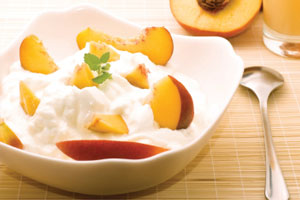Homemade yogurt
by Mary Ann Reese
This article was originally published in February 2010

(February 2010) — Are you hesitant to try plain yogurt because it might taste bitter? Try homemade yogurt. It is sweet even when unflavored, although you can add any flavor you like. Sweeten it with agave or pure maple syrup, or add organic berries, nuts or raisins. A squeeze of lemon is tasty, too.
Homemade yogurt tastes better than many store-bought varieties and can be healthier. When you make yogurt at home you can avoid added sugars and have total control over your ingredients.
The active bacterial cultures in yogurt aid in the digestion process, even for people with lactose intolerance. You can make yogurt using goat milk, cow milk, rice milk, soy milk or coconut milk. Probiotic fermentation also helps the circulatory system absorb nutrients.
Yogurt is made when milk is mixed with friendly probiotic bacteria, which are needed to break down amino acids, fats and sugars. It’s easy to make by mixing milk with yogurt starter and allowing time for the mixture to ferment. You can use a packaged starter (found in the dairy cooler of most PCC stores) or just mix in some previously made yogurt.
When the starter culture is mixed with warm milk, the friendly bacteria feed on the lactose, causing curdling. Any kind of milk — even nondairy milks — will curdle when culture strains are added, as long as you add a bit of maple syrup or agave during the mixing process. Nondairy milks contain no lactose, so an added sweetener is needed to help start the fermentation process.
(Note: Honey is not recommended to use as a sweetener in yogurt since it contains natural antibiotics, which can kill friendly bacteria in yogurt.)
Making yogurt
Fresh organic ingredients always will provide the best results for homemade yogurt.
-
Preparation:
- Choose the milk.
- Select a clean ceramic or glass mixing bowl and a wooden spoon.
- Heat milk in a saucepan or Crock-pot® to just below the boiling point.
- Turn off heat, cover and let cool to room temperature. This heating and cooling process ensures the thickest possible yogurt.
- Add fresh yogurt or purchased yogurt starter to the room-temperature milk. The ratio is 6 parts milk to 1 part yogurt. For instance, if you use 1/2 gallon of milk, add 1 1/4 cups of fresh yogurt as the starter. If you choose to use PCC’s dried yogurt starter, simply follow the directions on the package. Either way, whisk to dissolve.
- Using a dairy or candy thermometer, heat the milk to at least 70º F, but no higher than 100º F. Making it too hot will kill the live beneficial cultures. Heating lower than 70º F will slow the processing time (although the mixture still will ferment to a milder, less beneficial yogurt).
- Choose a processing method and time for your yogurt. Fermentation time is determined by your taste for yogurt. For a mild, drinkable yogurt, similar to kefir, plan about 4 hours. For a dense, somewhat more tart yogurt, plan about 8 hours.
Yogurt can be made in a bowl or a tempered jar — or you may decide to buy an electric yogurt maker for more precise temperature control. Some choose to leave yogurt to ferment on top of a heating pad, on low setting.
Store 1 1/4 cups of your fresh homemade yogurt in the refrigerator to use as a starter for a future batch.
Making yogurt cheese
Yogurt cheese is a delicious alternative to sour cream or cream cheese. This low-calorie, nutritious soft cheese will add flavor to any dish.
- Using a colander lined with two layers of cheesecloth, pour the yogurt into the cheesecloth.
- Gather up the corners and all the edges of the cheesecloth and secure with a string or rubber band to form a bag.
- Suspend this bag above a glass vessel to allow the whey to drip out of the cheesecloth bag.
This dripping setup can be on your kitchen counter, in the refrigerator, or elsewhere in an undisturbed area. Allow to drain for 12 to 30 hours, checking it periodically for firmness.
Use the finished product as you would any sour cream or cream cheese. The whey captured in the vessel can be used as a nutritious liquid in any soups or sauces.
Mary Ann Reese is a writer, editor and photographer. She directs and develops community gardens, preserves organic foods, and makes yogurt and kefir. She may be contacted at literaryleadership@gmail.com.
